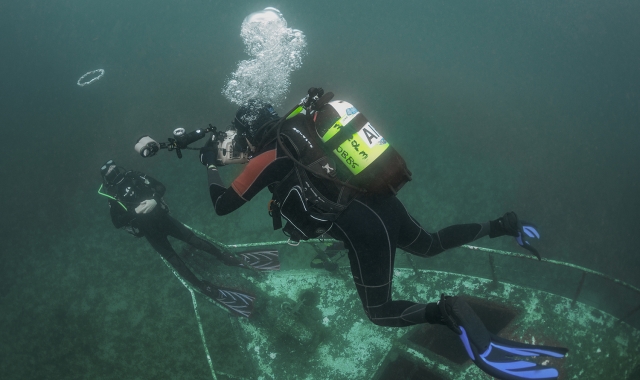- More More
- Blog
- Inspire me
- Groups
- Offers More
- Dive Courses More
- Liveaboards
More

Liveaboard Trips
On-board accommodation offering the opportunity to live right over the dive sites and to experience secluded dives...
Diving regions...
- LATEST AVAILABILITY BY REGION
- Red Sea availability
- Maldives availability
- Indonesian availability
- Socorro Mexico availability
- Galapagos availability
- ALL LIVEABOARD DIVING REGIONS
- Bahamas
- Bikini Atoll
- Caribbean
- Cocos Island
- Destinations
MoreDIVING REGIONS...
Our Top destinations....Why not try....
Find a trip
- Resort
- Liveaboard
Underwater Photo Q&A

2 Jul 2014, Jane H
From encounters with over-friendly dolphins to stage-managed shoots with crocodiles, Malcolm Nobbs has captured it all on camera. As the man behind the lens of so many of the outstanding images Regaldive use, Malcolm is certainly well-travelled. We managed to catch up with Malcolm at his home in Australia between trips (I don't think he had even unpacked his suitcase!) to find out a bit more about what's in his kit bag, his most memorable dives and where he's off to next!
Q.1: How did you get into underwater photography?
A.1: My first dive was near a small Egyptian town, Taba, in 1995. I was staggered to discover such a rich and vibrant world existed beneath the waves. Until then I’d had no idea what I had been missing - such stunning soft corals and colourful sea life. But straight away, like most divers, I had the urge to capture some memories to take home. So it wasn’t long before I took a video camera underwater and subsequently I switched to stills photography, which I found more satisfying.
Q.2: What is your most memorable dive?
A.2: Any dive when I make a major mistake is a memorable dive and haunts me for weeks afterwards. Having dived for 19 years I’ve made a number of stupid mistakes. But undoubtedly the worst was in July 2001 at the Blue Hole, Dahab, Egypt. The Blue Hole is literally a hole in the reef that is around 55 meters wide, 300 metres deep with an archway which leads out into the Red Sea. It is reputed to be the most dangerous dive site in the world and has claimed many lives. I first dived through the archway, on air, in April 2001, having previously done a series of deep dives to help build up my resistance to the mind-clouding effects of Nitrogen Narcosis. I put a lot of planning into this dive, had two independent tanks in case one failed and support divers and all went well. I recorded what was for me a new personal maximum depth of 59.7 metres.
Three months later I decided to repeat this, again on air, preparing as before with a number of deep dives and having support divers and taking two tanks. My initial decent was faster than on the previous occasion, dropping 40 metres in 3 minutes whereas previously I had taken almost 6 minutes. I think this was the cause of what was a new and frightening experience for me, a sudden and very strong sensation of nitrogen narcosis, causing me to misjudge my buoyancy control and hit a maximum depth of 70.4 metres as I exited the archway. Indeed I was close to losing control, and at that depth breathing air, vunerable to oxygen toxicity. Nevertheless within a minute I had ascended back up to 61 metres, three minutes later 50 metres and two minutes after that, 36 metres. As I ascended higher, all feelings of narcosis quickly left me. But not the realisation that I had really pushed my luck - I had totally underestimated the danger of narcosis at depth. How very stupid. It certainly remains my most memorable dive and the thought of it still embarrasses me to this day!
Q.3: You’ve travelled extensively… what’s your favourite destination, and why?
A.3: For liveaboard trips it has to be Costa Rica’s remote Cocos Island, well known for its huge schools of hammerhead sharks. With at least 27 endemic fish species it should be on every diver’s wish list. For shore and day boat dives, I'm totally sold on Australia. The variety of sea life is staggering, from the whale sharks of Ningaloo Reef on the west coast, to the leafy sea dragons and great whites of South Australia. New South Wales has sea lions, seals, weedy sea dragons, fantastic macro life and a wide range of sharks and then further up the east coast there is the beauty and marine treasures of the Great Barrier Reef and Coral Sea.
Q.4: What kind of camera equipment do you use?
A.4: In July 2012 I bought my present SLR, a Nikon D7000. It is a DX format camera like its predecessor the Nikon D200, enabling me to continue to use all my old D200's DX lenses. I have two Inon Z-240 strobes and my underwater housing is the Subal ND7000, rather rudely dismissed by my son as “looking like a container”.
Q.5: You’ve captured so many incredible moments… what’s your 'money shot'?
A.5: Possibly my best known 'money shot' is of a saltwater crocodile swimming between me and the bow of a dive boat. My dive buddy can be seen hiding behind the keel and looking up, a reflection on the water’s surface shows my wife looking down anxiously from the bow. It's proved a popular photograph. It’s also a fraud, totally stage-managed by me, even down to the contrived reflection. The crocodile was less than two metres long and had a rope tied to its tail so that it could not reach me. I photo-shopped that out later. My buddy was not hiding behind the keel, he was holding onto the rope with one hand, the keel with the other. My wife was not anxious, just fed up that I was taking so long to take the shot.
Q.6: Any particularly tricky subjects or hairy moments underwater?
A.6: Although I have dived in open water with many types of sharks including great whites, oceanic whitetips, tigers and bull sharks, I have to say I’ve rarely felt in danger. Despite some at times hysterical media coverage to the contrary, most marine life is very cautious. Their motto seems to be: if in doubt, leave alone. To marine life, divers with scuba tanks sound very noisy. We probably seem like strange aliens and best avoided! However “silent” surfers and swimmers can be mistaken for natural prey and clearly this is a concern. But bizarrely, what I think was my most hairy moment was an encounter with an overfriendly large bottlenose dolphin! I was diving near my old home town Folkestone, UK for what was intended as a simple shallow dive on 'my home patch'. The dolphin must have heard my bubbles underwater and decided to check me out. She began to play with me, spinning faster and faster around and around me. The underwater visibility turned to zero. She seemed so huge and powerful. Even though I knew that she had no aggressive intentions towards me, I felt very vulnerable. Eventually she stopped and opened her mouth right in front of my face. It seemed very large! I kept still and she eventually became bored and disappeared.
Q.7: Any tips for budding photographers, underwater, or topside?
A.7: I can't offer any great insights into topside photos but hopefully I can do better underwater. For a start you need good diving skills. Sometimes you have to try and remain in a fixed position to photograph, perhaps fighting a current or twisting at some awkward angle, and you often have to keep still. Move too quickly and you can frighten your subject. Be clumsy and you can cause damage. Correct lighting is an essential element of a good underwater photograph. If the natural light is poor, you need to compensate with some flash, ideally from an external flash gun, rather than one built into the camera. Getting close to a subject is generally essential. Unfortunately if there are particles in the water, the flash will illuminate the particles in front of your lens, thereby spoiling your shot. But you can avoid this if you use an external flash gun, angled so that it lights up your target but not the water between your camera lens and your subject. My goal is always to try and make it seem as though the subject is relaxed and interested in me and eye contact from the subject to my camera lens helps achieve this illusion.
Q.8: What’s next on your diving wish list?
A.8: For me, it’s all about the marine life I hope to see. My next dive trip is to South Australia where I’m hoping to see great whites larger than any I’ve seen before, then Indonesia's Cendrawasih Bay to, fingers crossed, photograph whale sharks sucking small silverside baitfish out of fishermen’s nets. I failed to see any sailfish when I visited Mexico last year, so next year I’m going back to try again and on the same trip I hope to see great hammerheads off the Caribbean's Bimini Islands. My diving wish list just seems to grow bigger and bigger but next year I plan to tick off another must-do, South Africa’s Sardine Run...
We asked Malcolm to cpmpile his top 10 shots... Take a look at the album on our Facebook page here >
For more information or to see more of Malcolm's photographs, see www.malcolmnobbs.com





